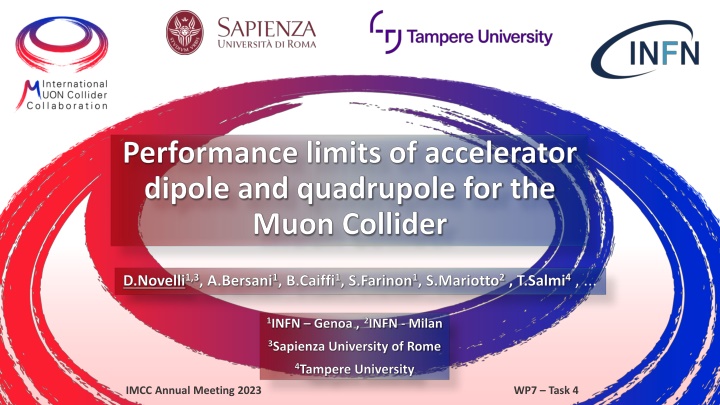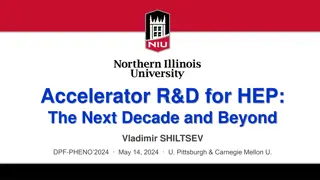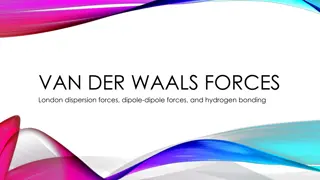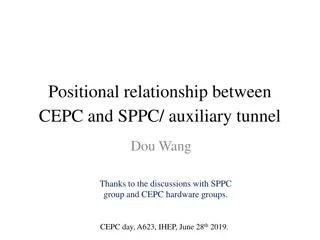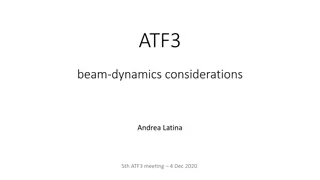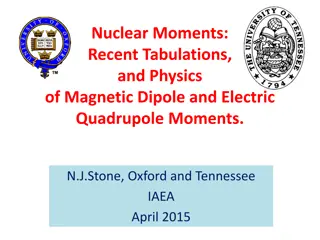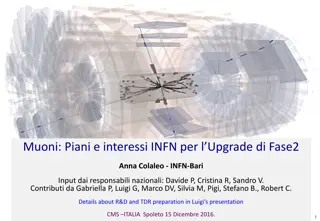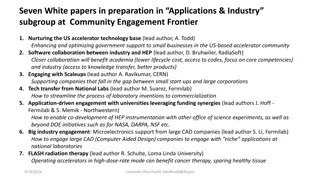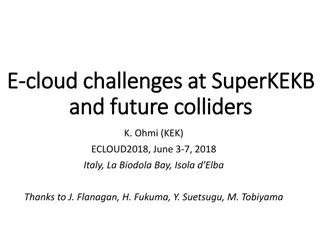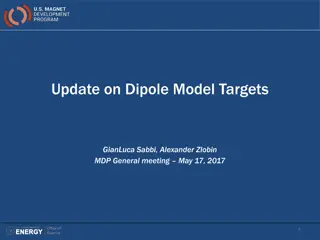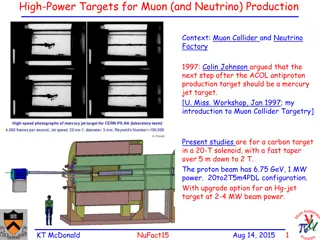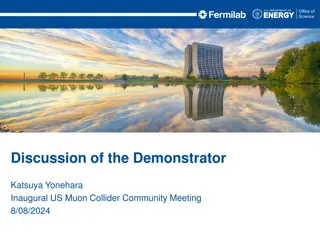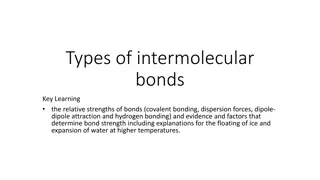Performance Limits of Accelerator Dipole and Quadrupole for Muon Collider
Utilizing Python code, the study analyzes the limits of accelerator dipole and quadrupole for the Muon Collider. Analytic formulas are implemented to assess the behavior of these components based on critical current density, operating temperatures, and superconductor materials. The study explores limitations associated with superconductor properties and discusses margins related to enthalpy and temperature. Considerations for mechanical stress, cost, and protection are also evaluated through bore diameter versus magnetic field graphs. The analysis introduces general assumptions, dipole magnetic field, quadrupole gradient, and discussions on margins.
Download Presentation

Please find below an Image/Link to download the presentation.
The content on the website is provided AS IS for your information and personal use only. It may not be sold, licensed, or shared on other websites without obtaining consent from the author.If you encounter any issues during the download, it is possible that the publisher has removed the file from their server.
You are allowed to download the files provided on this website for personal or commercial use, subject to the condition that they are used lawfully. All files are the property of their respective owners.
The content on the website is provided AS IS for your information and personal use only. It may not be sold, licensed, or shared on other websites without obtaining consent from the author.
E N D
Presentation Transcript
Performance limits of accelerator dipole and quadrupole for the Muon Collider D.Novelli1,3, A.Bersani1, B.Caiffi1, S.Farinon1, S.Mariotto2, T.Salmi4, ... 1INFN Genoa ,2INFN - Milan 3Sapienza University of Rome 4Tampere University IMCC Annual Meeting 2023 WP7 Task 4
Introduction A Python code is used to implement the analytic formulas for the dipole and quadrupole in cos-theta and sector coil approximation. Starting from the fit of the critical current density, the short sample magnetic field (dipole) and the short sample gradient (quadrupole) are computed, for three different operating temperatures and superconductors. This provides the limitations due to the nature of the superconductor itself as a function of temperature, type of material and quantity of material (coil width). By adding a margin to the short sample values, the graphs become more realistic. This is followed by a discussion of margin in terms of enthalpy and temperature A graph of the bore diameter versus magnetic field is useful to show the allowed region taking into account the mechanical (stress), cost and protection limitations. Some approximations are used to validate the procedure, and then more complicated configurations will be studied (for example sector magnets at a higher order of approximation, with iron yoke and grading on the current density). 1 IMCC Annual Meeting 2023 WP7 Task 4
General Assumptions This work is under the no-iron hypothesis. Analytic formulas in cos-theta approximation or, similarly, in sector coil (60 for the dipole and 30 for the quadrupole) at the first order of approximation. Temperature of the cold mass, 3 options: 1.9 K NbTi 4.2 K Nb3Sn and ReBCO 20 K ReBCO Superconducting materials: NbTi Nb3Sn ReBCO the LHC cable as a reference the FCC target performance as a reference Filling factor of pure superconductor = 0.3 the Fujikura FESC AP tape as a reference Filling factor of pure superconductor = 0.02 Filling factor of pure superconductor = 0.27 2 IMCC Annual Meeting 2023 WP7 Task 4
Dipole Magnetic Field These margins are indicative; they are used to observe behaviour. The coil width will be strongly limited by the cost. The magnetic field will be strongly limited by the stress. 3 IMCC Annual Meeting 2023 WP7 Task 4
Quadrupole Gradient These margins are indicative; they are used to observe behaviour. The coil width will be strongly limited by the cost. The gradient will be strongly limited by the stress. 4 IMCC Annual Meeting 2023 WP7 Task 4
Discussion on the Margins The margin on the load line can be expressed in terms of margin in temperature. We have chosen two indicative and reasonable values for margins on the load line for LTS and HTS, which are: 20% for the LTS (graph on the left) and 5% for the HTS (graph on the right). We can reduce (below 20%) the margin on the load line for the Nb3Sn. We can reduce (below 5%) the margin on the load line for the ReBCO at high temperatures. 5 IMCC Annual Meeting 2023 WP7 Task 4
Discussion on the Margins It s more physical talking about the enthalpy margin, which is linked to the temperature margin through the thermal capacity of the materials and the compositions of the strands. Material Operating Temp. [K] Enthalpy Margin [mJ/cm3] Temperature Margin [K] Strand fraction Cost Stress Limit NbTi 1.9 5 2 0.75 200 /kg 100 MPa Nb3Sn 4.2 20 4.5 0.70 2000 /kg 150 MPa 4.2 20 4.8 ReBCO 0.73 8000 /kg 300 MPa 20 90 0.35 NbTi Nb3Sn HL-LHC standard Strand Fraction = 0.40 (Cu) + 0.30 (Sc) ReBCO Enthalpy margin equal to HL-LHC Strand Fraction = 0.20 (Cu) + 0.02 (Sc) + 0.01 (Ag) + 0.50 (Hastelloy) LHC standard Strand Fraction = 0.48 (Cu) + 0.27 (Sc) Assume a cost limit of 100 k for the bare superconductor (the same limit for each material). 6 IMCC Annual Meeting 2023 WP7 Task 4
Bore Diameter vs Magnetic Field Material Operating Temp. [K] Enthalpy Margin [mJ/cm3] Temperature Margin [K] Strand fraction Cost Stress Limit NbTi 1.9 5 2 0.75 200 /kg 100 MPa Assumption of J0 as Jc for each value of the magnetic field For each value of the magnetic field one can compute Jc(B, T) Knowing B and J0, the coil width can be computed from the load line formula The coil width increase with increasing B and decreasing Jc 7 IMCC Annual Meeting 2023 WP7 Task 4
Bore Diameter vs Magnetic Field Material Operating Temp. [K] Enthalpy Margin [mJ/cm3] Temperature Margin [K] Strand fraction Cost Stress Limit Nb3Sn 4.2 20 4.5 0.70 2000 /kg 150 MPa Assumption of J0 as Jc for each value of the magnetic field For each value of the magnetic field one can compute Jc(B, T) Knowing B and J0, the coil width can be computed from the load line formula The coil width increase with increasing B and decreasing Jc 8 IMCC Annual Meeting 2023 WP7 Task 4
Bore Diameter vs Magnetic Field Material Operating Temp. [K] Enthalpy Margin [mJ/cm3] Temperature Margin [K] Strand fraction Cost Stress Limit 4.2 20 4.8 ReBCO 0.73 8000 /kg 300 MPa 20 90 0.35 Knowing B and J0, the coil width can be computed. Assumption of J0 as Jc for each value of the magnetic field The coil width increase with increasing B and decreasing Jc For each value of the magnetic field one can compute Jc(B, T) 9 IMCC Annual Meeting 2023 WP7 Task 4
Bore Diameter vs Magnetic Field A studied option is to fix the current density (450 A/mm2, for example). This is interesting because using J0 as Jc, in each point of the magnetic field we are using the maximum current density allowed by the properties of the material, but, of course, this is not usually done. We will work below the critical current density, particularly at low fields. Also, working at the maximum current density can be a problem for the protection of the magnet; it should require huge coil width to dissipate the energy in case of quench. A solution can be found using a graded current density between LF and HF. ????? Limited by the cost and stress ReBCO is limited by the cost ?bTi Limited by the stress 10 IMCC Annual Meeting 2023 WP7 Task 4
Protection Limit for Constant Cost NbTi, Hotspot temperature limit 350 K : Low conductor cost allows large coil and low current density protection does not limit design Nb3Sn, hotspot temperature limit 350 K: Higher cost starts to limit the coil size and force higher current density protection may become a limitation NbTi Courtesy by Tiina Salmi ReBCO, hotspot temperature limit 200 K: High cost requires small coil and very high current density Protection will be a limiting factor Nb3Sn ReBCO 4 K & 20 K In all cases we assume 40 ms protection delay between original quench and quench protection system efficiency, see details: https://indico.cern.ch/event/1240045/ 11 IMCC Annual Meeting 2023 WP7 Task 4
Conclusions Upcoming developments: We are currently working with analytical formulae in cos-theta and sector coil approximation. We are working to include a linear iron yoke (still using an analytical approach). We plan to include a current grading between LF and HF. We are looking for the best way to get the bore diameter vs magnetic field graph. For the future: We would like to implement a Python code able to work with the Ansys software, to solve complex configurations that are not analytically tractable, thus making it possible to study multipole sectors and combined function magnets. 12 IMCC Annual Meeting 2023 WP7 Task 4
Thank you for your attention IMCC Annual Meeting 2023 WP7 Task 4
Dipole - Performances of NbTi Ratio between normal conductor and superconductor. Voids Insulation Fit s data from the LHC cable Fixed aperture = 75 mm T = 4.2 K Filling factor = 0.3 Cos? configuration w = 30 mm 14 27/04/2023 WP7 Task 4
Dipole - Performances of Nb3Sn Ratio between normal conductor and superconductor. Voids Insulation Fit s data from the FCC target performance Fixed aperture = 75 mm Filling factor = 0.3 Cos? configuration T = 4.2 K w = 30 mm 15 27/04/2023 WP7 Task 4
Dipole - Performances of YBCO Fit s data from the Fujikura FESC AP tape Fixed aperture = 75 mm Filling factor = 0.02 Cos? configuration Ratio between the total area of the cable to the superconductor area. T = 4.2 K w = 30 mm 16 27/04/2023 WP7 Task 4
